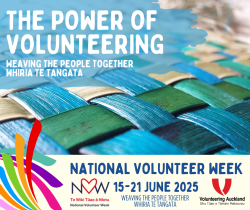Weaving the People Together: The Power of Volunteering – Whiria Te Tangata

Volunteering is the backbone of strong communities, bringing together individuals from all walks of life to contribute their time, skills, and passion for the greater good. In Aotearoa New Zealand, the concept of whiria te tangata—weaving the people together—beautifully encapsulates the essence of volunteering. Like strands of flax interwoven to form a resilient and unified fabric, volunteering connects people across generations, cultures, and experiences, fostering a society that is more inclusive and compassionate.
The Power of Connection Through Volunteering
Volunteering does more than just provide support for those in need—it builds bridges between individuals and strengthens the fabric of communities. By engaging in meaningful service, people forge relationships, develop a sense of belonging, and gain new perspectives.
In today’s increasingly diverse and intergenerational society, the importance of fostering connections between different groups cannot be overstated. Community organisations have a unique opportunity to facilitate these relationships through volunteer initiatives that embrace diversity and inclusion.
Intergenerational Volunteering: Bridging the Gap Between Youth and Seniors
One of the most effective ways to weave people together is through intergenerational volunteering. Bringing youth and seniors together creates mutual learning opportunities and combats issues such as loneliness, social isolation, and generational divides.
Example: Digital Mentorship Programmes
A great initiative is pairing tech-savvy youth with older adults in digital mentorship programmes. Young volunteers can teach seniors how to use smartphones, social media, and online services, while elders can share life experiences, wisdom, and cultural knowledge. Programmes like these not only help seniors stay connected with their families but also foster meaningful friendships across generations.
Example: Community Gardening Projects
Community gardening is another initiative that connects young and older volunteers. Seniors contribute their gardening knowledge, while younger participants bring energy and strength to help with physical tasks. Together, they cultivate not only crops but also friendships, storytelling, and a sense of shared achievement.
Embracing Cultural Diversity in Volunteering
Aotearoa New Zealand is home to a rich tapestry of cultures, including Māori, Pasifika, Asian, and migrant communities. Volunteering offers a powerful platform to celebrate and integrate diverse perspectives while fostering understanding and inclusion.
Example: Multicultural Food Festivals
Community organisations can organise multicultural food festivals, where volunteers from different backgrounds share their traditional cuisines, cooking techniques, and stories. Food is a universal language that brings people together, encouraging cross-cultural exchange and strengthening community ties. Volunteers play a key role in organising, cooking, and serving, creating an environment of hospitality and collaboration.
Example: Language and Cultural Exchange Programmes
Language barriers can sometimes prevent people from fully participating in society. By establishing volunteer-led language and cultural exchange programmes, communities can create spaces for migrants, refugees, and indigenous groups to learn from each other. Volunteers can act as language tutors or cultural ambassadors, helping newcomers integrate while also learning about different traditions and worldviews.
Volunteering for Social and Environmental Good
Beyond intergenerational and cultural connections, volunteering is an essential tool for social and environmental sustainability. Bringing diverse groups together for a common cause strengthens the commitment to collective well-being and shared responsibility for the planet.
Example: Beach and Park Clean-Ups
Environmental volunteer initiatives, such as beach and park clean-ups, are excellent ways to unite people from different backgrounds. These activities create an immediate impact while fostering teamwork and environmental stewardship. They also provide an opportunity for volunteers to share traditional and indigenous ecological knowledge, such as Māori perspectives on kaitiakitanga (guardianship of the land and water).
Example: Community Housing and Building Projects
Habitat restoration, home-building, and community improvement projects are other ways to engage diverse volunteers in meaningful work. Groups with different skill sets can come together—some providing hands-on labour, others offering organisational or design expertise—creating a true sense of cooperation and collective achievement.
Strengthening Volunteering Infrastructure
For volunteering to be effective in weaving people together, community organisations must create an inclusive and supportive infrastructure that encourages participation from all sectors of society.
Providing Accessible Volunteering Opportunities
It is essential to ensure volunteering opportunities are accessible to everyone, regardless of age, ability, or background. This can be achieved by offering flexible hours, transport support, and roles that accommodate different skill levels and physical abilities.
Recognising and Celebrating Volunteers
Acknowledging the contributions of volunteers fosters a sense of belonging and encourages continued participation. Organisations can hold volunteer appreciation events, issue certificates of recognition, and share success stories to highlight the impact of volunteers on the community.
Collaborating with Local Groups and Businesses
Partnerships between community groups, businesses, and local government can enhance volunteering efforts by providing additional resources and expertise. Encouraging employers to support volunteer days or community service leave can also increase participation.
Conclusion: The Strength of a Woven Community
Incorporating the philosophy of whiria te tangata—weaving the people together—into volunteering efforts ensures that communities become more resilient, connected, and compassionate. By creating opportunities for intergenerational, intercultural, and social collaboration, community organisations can foster a more inclusive and thriving society. Volunteering is not just about giving time; it is about creating relationships, sharing knowledge, and working together towards a common good. When people come together in service, they weave a stronger, more united community—one that can stand the test of time, just like the beautifully woven fibres of a harakeke (flax) basket.

